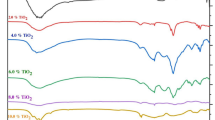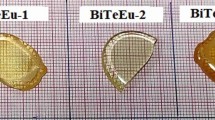Abstract
The mechanical properties of glasses in the Li2O–B2O3–P2O5 system are investigated as a function of the boron oxide content in the range from 5 to 30 mol % at a constant lithium oxide content of 45 mol %. It is demonstrated that, as the B2O3 content increases, the density of glasses passes through a maximum at 20 mol % B2O3 and the molar volume decreases gradually. The elastic modulus and the hardness of glasses monotonically increase with an increase in the B2O3 content. An increase in the B2O3 content leads to a decrease in the structural strength (measured using the method of three-point bending of fibers) and the fracture toughness (determined by the microindentation technique). The assumption is made that the decrease in the strength characteristics is caused by the phase separation developed in the structure of lithium phosphate glass with an increase in the B2O3 content.
Similar content being viewed by others
REFERENCES
Ray, N.H., Composition-Property Relationships in Inorganic Oxide Glasses, J. Non-Cryst. Solids, 1974, vol. 15, no. 3, pp. 423–434.
Ray, N.H., A Study of the Coordination of Boron in Potassium Borophosphate Glasses by Raman Spectroscopy, Phys. Chem. Glasses, 1975, vol. 16, no. 4, pp. 75–80.
Kolesa, V.A., A Study of the Structure of Oxide Glasses by Vibrational Spectroscopy, Fiz. Khim. Stekla, 1983, vol. 9, no. 3, pp. 257–266.
Ducel, J.F., Videau, J.J., and Couzi, M., Structural Study of Borophosphate Glassed by Raman and Infrared Spectroscopy, Phys. Chem. Glasses, 1993, vol. 34, no. 5, pp.–212–218.
Pesina, T.I., Romanenko, L.V., Pukh, V.P., and Novak, I.I., Strength and Structure of Glasses in the Na2O-B2O3 System, Fiz. Khim. Stekla, 1981, vol. 7, no. 1, pp. 68–72.
Pesina, T.I., Baikova, L.G., Pukh, V.P., Novak, I.I., and Kireenko, M.F., Strength and Structural Features of Glasses in the Na2O-Al2O3-SiO2 System, Fiz. Khim. Stekla, 1986, vol. 12, no. 1, pp. 26–31.
Pukh, V., Baikova, L., and Pesina, T., Structural Strength of Glasses, in Proceedings of II Conference of the European Society of Glass Science and Technology, Venice, 1993, pp. 339–344.
Baikova, L.G., Fedorov, Yu.K., Pukh, V.P., Pesina, T.I., Kazannikova, T.P., Tikhonova, L.V., and Kireenko, M.F., Effect of Cation Field Strength on the Mechanical Properties of R2O-Al2O3-P2O5 Glasses, Fiz. Khim. Stekla, 1993, vol. 19, no. 5, pp. 725–731 [Glass Phys. Chem. (Engl. transl.) 1993, vol. 19, no. 5, pp. 380–383].
Tatsumisago, M., Kowada, Y., and Minami, T., Structure of Rapidly Quenched Lithium Phosphate Glasses, Phys. Chem. Glasses, 1988, vol. 29, no. 2, pp. 63–66.
Jin Yifen, Chen Xiangsheng, and Huang Xihuai, Raman Studies of Lithium Borophosphate Glasses, J. Non-Cryst. Solids, 1989, vol. 112, no. 1, pp. 147–150.
Pukh, V.P., Pesina, T.I., and Ivanov, M.I., Measurements of the Strength of Thin Glass Fibers by Lateral Bending Technique, Fiz. Khim. Stekla, 1981, vol. 7, no. 3, pp.–328–331.
Anstis, G.R., Chantikul, P., Lawn, B.R., and Marshall, D.B., A Critical Evaluation of Indentation Techniques for Measuring Fracture Toughness: I. Direct Crack Measurements, J. Am. Ceram. Soc., 1981, vol. 64, no. 9, pp. 533–538.
Weibull, W.J., A Statistical Distribution Function of Wide Applicability, J. Appl. Mech., 1951, vol. 18, no. 3, pp. 293–297.
Lawn, B.R., Dabbs, T.P., and Fairbanks, C.J., Kinetics of Shear-Activated Indentation Crack Initiation in Soda-Lime Glass, J. Mater. Sci., 1983, vol. 18, pp. 2785–2793.
Eagan, R.J. and Swearengen, J.C., Effect of Composition on the Mechanical Properties of Aluminosilicate and Borosilicate Glasses, J. Am. Ceram. Soc., 1978, vol. 61, nos. 1–2, pp. 27–30.
Shinkai, N., Bradt, R.C., and Rindone, G.E., The KIC to E Relationship in Phase-Separated Glasses, J. Non-Cryst. Solids, 1982, vol. 49, no. 3, pp. 497–506.
Vernaz, E., Larche, F., and Zarzycki, J., Fracture Toughness-Composition Relationship in Some Binary and Ternary Grass Systems, J. Non-Cryst. Solids, 1980, vol. 37, no. 3, pp. 359–365.
Miyata, N. and Jinno, H., Strength and Fracture Surface Energy of Phase-Separated Glasses, J. Mater. Sci., 1981, vol. 16, pp. 2205–2217.
Makishima, A. and Mackenzie, J.D., Direct Calculation of Young's Modulus of Glass, J. Non-Cryst. Solids, 1973, vol. 12, no. 1, pp. 35–45.
Author information
Authors and Affiliations
Rights and permissions
About this article
Cite this article
Baikova, L.G., Fedorov, Y.K., Pukh, V.P. et al. Influence of Boron Oxide on the Physicomechanical Properties of Glasses in the Li2O–B2O3–P2O5 System. Glass Physics and Chemistry 29, 276–281 (2003). https://doi.org/10.1023/A:1024486116145
Issue Date:
DOI: https://doi.org/10.1023/A:1024486116145




